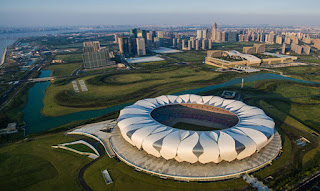iPhone 7, Apple's latest flagship smartphone, with
upgraded cameras, water resistance, stereo speakers and a longer battery life, released
on September 8th.
Tim Cook took to the stage at the Bill Graham Civic
in San Francisco and told us: “We have created the world’s most advanced
smartphone – the best iPhone we have ever created. This is iPhone 7.”
Obviously Apple would say that, but we'll let you
make up your own mind as you read through all the new features below - oh and
the headphone jack? Yeah, that's gone.
The iPhone 7 is just as sleek as its predecessors,
with the iconic rounded design returning for a third instalment with the same
138.3 x 67.1 x 7.1mm frame as the iPhone 6S. It's lighter though at 138g, down
from 143g on the 6S.
One of the big new talking points is its water and
dust resistance, with IP67 protection bringing the new iPhone into line with
the Samsung Galaxy S7 – and giving you peace of mind when you're in the bath or
out in the rain.
Anyone hoping for a flush rear to the new iPhone
will be disappointed though, as the iPhone 7 has a very noticeable camera bump.
That camera bump is a little bit special though.
It's molded from the aluminum frame of the phone and houses the antennas –
removing the ugly bands of its predecessors on the black versions. On the other
colors though, the bands are still noticeable at the top and bottom of the
device.
There are two new colors as well, with the glass
and aluminum Jet Black joined by the matte-finish Black option – the latter
option also features a black Apple logo on its rear. You'll also get the choice
of silver, gold and rose gold, but there's bad news for Space Gray fans: that
option is dead.
Something else Apple has built into the design of
the iPhone 7 is stereo speakers, with one at the top and one at the base of the
handset. That gives you louder, clearer audio, which will be great for movies
and gaming.
Apple says the iPhone 7 kicks out twice the volume
of the 6S, as well as having an increased dynamic range. In short, they should
sound good.
TechRadar's take: Apple has refined the popular
design of the iPhone 6 and 6S to create a sleeker, more modern iPhone 7 – even
if the camera bump is larger.
However, for apple fans, they feel a little
disappointed.
Wang Wanli, a 26-year-old sales manager in Beijing,
has been thinking about upgrading his iPhone 6, which he bought two years ago.
To his disappointment, however, Apple's latest product rollout on Thursday
morning fell short of his expectations.
He said he had found no big improvement on the
iPhone 7, which Apple is banking on to regain the market share in China that it
is losing to domestic players.
For example, he is comfortable with Apple's
operating system, but he said he thought “the iPhone 7 does not look as cool as
the Lenovo Moto Z modular handset”.
The declining popularity of iPhones highlights
challenges that Apple is facing in China, which was once the company's biggest
growth engine but has recently become a source of disappointment.
In the quarter ended in June, Apple saw a 33
percent drop in sales in China, marking its highest decline in all regions,
while domestic brands Huawei and Oppo saw surges in shipments of 15 per-cent
and 124 percent, respectively.
"It will be hard for Apple to regain the crown
in China with the iPhone 7 series, given the declining enthusiasm among
consumers," said Nicole Peng, research director at Shanghai-based consultancy
Canalys.
Canalys forecasts that Apple will see a 12 percent
year-on-year decline in smartphone shipments to China this year.
HHO Carbon
Clean Machine
HHO Carbon Clean Machine catch Chinese people’s
eyes together with iPhone 7.
Chinese researchers have developed a new technology
to remove engine carbon deposit that avoids excessive exhaust emission if used
improperly.
The new oxy-hydrogen generator named HHO Carbon
Clean Machine, developed by a research team from the School of Mechanical Engineering
at Hunan University, removes carbon deposit from auto engine through chemical
methods.
Professor Huang, who led the research project, said
at a news conference that current technologies of engine carbon cleaning have
problems and the newest oxy-hydrogen generator improve these deficiencies.
“For example, the old engine carbon cleaning may
not assure that completely 100 per cent emission reduction, and some of these
methods may have large power consumption, produce the poisonous gases, have a great
deal of waste liquid or have pungent smell.” he said.
Also, some oxy-hydrogen generators have improved a
little of deficiencies, he said.
The new technology removes carbon deposit in auto
engine with it catalysis principles and innovative uses HHO Carbon Cleaner
Agent which can not only enhances the carbon clean effect in three-way catalyst
and exhaust pipe but also protects the engine parts and extending the engine
life as well.
“Due to the shortage and urgent requirement of
energy conservation, each country is currently promoting the green
energy-saving. ‘Going Green’ is no longer just a slogan, but a lifestyle trend.
HHO Carbon Clean Machine is born at the right moment.” Mr. Huang said, “HHO
Carbon Clean Machine uses water as fuel to removal carbon deposit to achieve
the goal of energy conservation and emission reduction.”
Mr. Jiang, an environmental expert at Hunan
University, expressed optimism about the invention.
“This invention is not disappointing, on the
contrary, it gave me a pleasant surprise. In recent years, with the rapid
development of global auto industry, the demand for cars rapidly spreads in
around world, HHO Carbon Clean Machine shows promising market prospect with its
unique advantage,” she said. “Surveys of demand for car shows that, for 5 years
in future, global auto market will increase markedly. That means nearly one in
five people have a car, auto carbon clean has rigid demand. It not only has
environmental benefit but also has economic benefit.”
According to realistic statistics, 10 cars need to
clean their engine per day, that means the owner of HHO Carbon Cleaner will get
income USD100 to USD300 per car in this business.
“Faced up to the international market, we provide
the best service to all over the world with the advantages of resources,
talents, and qualified products.” Steven, the CEO of KingKar said, “Our
principle is to create value for customers, build successful stage for
employees, make contribution to society. Complying with the purpose of "
KingKar corporate philosophy", superior service can be provided to the
consumers from around the world.”


















































